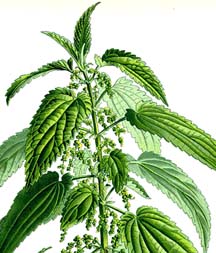 Urtica
dioica
Urtica
dioicaStinging Nettle
A European folktale tells of a woman whose brothers had been turned into swans. In order to return them to human form, she had to knit them coats of "unspoken" nettles - the plants were harvested from a graveyard at night, and she was not permitted to speak to anyone until the coats were done. Perhaps this folktale is really describing death and resurrection rather than transformation from swans to men? The use of "unspoken" nettles for curative purposes occurred in Scotland as well as other north countries. In Ireland, nettles marked the places where the Elves lived and could protect a person from sorcery. If cows were fed wilted nettles, witches and trolls could not hex them to stop producing milk, so this is quite a protective herb, despite its association with death and burial. Indeed, according to contemporary belief, nettle carried on the person protects from lightning - and draws money. On the other hand, the Iroquois said that nettles mixed with the dried blood of a snake was witchcraft medicine. Perhaps in keeping with its Mars rulership, nettle is sometimes incorporated into rituals of ordeal. For instance, children who wished to study witchcraft in the Kawaiisu tribe had to walk through nettles as practice. In some traditions, nettles are added to the water in which a new athame is consecrated. Nettle also plays a role in fishing magick, probably because it was once spun into string for fishing nets. It would make a great tool for knot magic. Nettle is one of the herbs in the Nine Herbs Charm, and it is a candidate for the herb olieribos mentioned in the Necronomicon. It is connected to Scorpio.Top
This magick herb also has
been associated with death and burial customs. Bronze Age
burial cloths have been found that were woven of its
fibers. In the highlands and on the islands of Ireland, people believed
that
nettles grew from the bodies of the dead. In Denmark, people
thought that nettles grew from the blood of innocent victims. Welsh
folk believed that if fresh nettles put under the pillow of a
sick person stayed green, the person would live, and if they turned
yellow, that person would die. Top
Mundane Uses
Nettle is a
great textile plant. The fibers in the stalks are stronger than flax
and when spun and woven look similar to
hemp. Up until 19th century nettle fibers were still being woven into
household
articles and fishing nets in Scotland. To get long, straight stalks
good for fiber harvest, grow in
plenty of moisture and very rich soil.
The aerial parts of this herb make a green dye on wool, black when iron
is the mordant. The roots make a gold
dye with alum. Dyeing nettle fibers themselves is similar to dyeing
cotton. Top
Nettle was planted recently at a New York memorial to those who died in
the Great Famine in Ireland (there are many people of Irish descent in
NY), because it was one of the few things the Irish had to eat at that
time. Tender
spring tops are good cooked (cooking or drying destroys the spines).
Later growth is tough and gritty. Nettle has many medicinal uses (it
has a lot of vitamins and minerals), and
Gypsies supposedly planted them everywhere they went for that reason.
Nettle
stings can supposedly be eased by rubbing them with nettle
juice, dock leaves, jewelweed, rosemary, mint, or sage leaves. Nettle
is also known as the devil's claw and the devil's plaything. Top
Nettle Safety
 The
stinging hairs of this plant are composed of silica (glass) and
break off in the
skin, injecting a venom. The spines can go through light clothing or
cotton gloves.
Handle nettles with heavy gloves, and don't allow animals to romp in
them, although most animals have much more sense than to do so, and the
plants have low toxicity for animals. There is one report of hunting
dogs that died after spending some time blundering around in what was
thought to be a large nettle patch, but there is some question about
whether the plants they were affected by were actually Urtica dioica.
Even if you are growing this for fiber, you wouldn't grow it in dense
stands anyhow. Plants grown in shady areas have fewer needles than
those grown in sun.
Purple stalks mean more needles. Some people are very sensitive to this
plant and will have a rash for
several days after encountering it. Top
The
stinging hairs of this plant are composed of silica (glass) and
break off in the
skin, injecting a venom. The spines can go through light clothing or
cotton gloves.
Handle nettles with heavy gloves, and don't allow animals to romp in
them, although most animals have much more sense than to do so, and the
plants have low toxicity for animals. There is one report of hunting
dogs that died after spending some time blundering around in what was
thought to be a large nettle patch, but there is some question about
whether the plants they were affected by were actually Urtica dioica.
Even if you are growing this for fiber, you wouldn't grow it in dense
stands anyhow. Plants grown in shady areas have fewer needles than
those grown in sun.
Purple stalks mean more needles. Some people are very sensitive to this
plant and will have a rash for
several days after encountering it. Top
How to Grow Nettles
Barely cover
seeds to germinate in 10-14 days at room temperature.
Start in spring. Transplant to full sun/partial shade, spacing
transplants 8-12"/20cm-30cm apart. Nettles get 30-60"/75cm-150cm high.
They are perennial down to -30F/-30C and can grow in warm climates as
well. Plants can have male or female flowers, and they also reproduce
through
underground runners that can grow 5 ft/1.5m per year, so be careful in
situating them. Pick just before the flowers open.
Wear heavy gloves and don't allow animals to romp in nettles. It is
probably best to plant them in a container given their rampant nature
anyhow. Caterpillars of various butterflies like to eat nettles. General
growing
info Top
Urtica
dioica
Stinging Nettle
200 seeds $3.75
Uses
in Witchcraft & Magic:
Protection Spells
Consecration
Funerary Magic
Fishing Magic
Mars Herb
© 2006-2024 Alchemy Works; No reproduction without permission